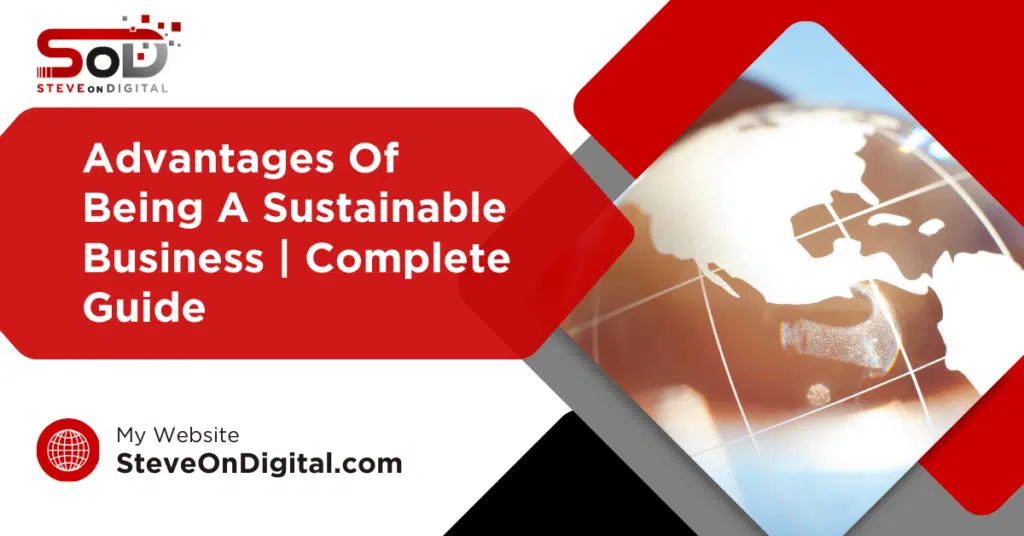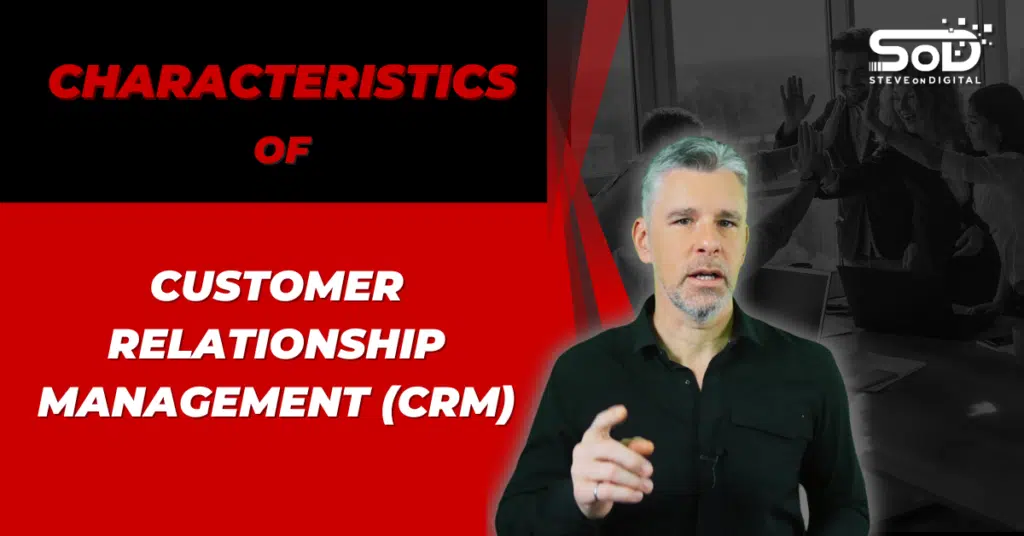Advantages Of Being A Sustainable Business | A Comprehensive Guide

Hello, I’m Steve Johnston, owner and author of SteveOnDigital, specializing in guiding small and medium-sized businesses through digital transformation. With a background in electrical engineering, an MBA, and a master’s in Project Management, I bring a depth of knowledge to help over a million business leaders optimize their digital strategies. My approach is deeply personal, reflecting my commitment to family, continuous learning, and active involvement in community and economic development initiatives. In this blog post, I will explore the profound advantages of being a sustainable business. Sustainability is more than just an environmental gesture; it is a comprehensive approach that integrates environmental, social, and economic factors into the core operations of a business. This not only aims for profitability but also fosters a thriving environment and community engagement. Over the years, I’ve witnessed the evolution of sustainable practices from niche strategies to fundamental business imperatives, driving not only growth but also fostering a resilient and adaptable future. Understanding Sustainable Business Defining Sustainable Business As I’ve observed in the digital transformation landscape, a sustainable business actively integrates environmental, social, and economic factors into its operations. This means not just aiming for profitability but also caring for the planet and people. It’s about creating a business that not only survives but thrives by respecting and enhancing the resources it depends on. Incorporating a sustainable approach into business strategies is crucial, as it underscores the importance of addressing global challenges while aiming for financial success and a positive impact on both society and the environment. Adopting a sustainable business model is key to ensuring long-term business success and resilience, as it opens up opportunities for economic growth, increases productivity, potentially cuts costs, and positions companies as leaders in tackling climate change and meeting consumer demands. Evolution Of Sustainability In The Business World From my years of experience, I’ve seen how the importance of sustainability in business has evolved from a niche advantage to a core necessity, highlighting why sustainability important is a key factor in business success today. Initially, it was about reducing waste and conserving energy, but now it encompasses sustainability initiatives aimed at leading a brand towards a more resilient and adaptable future. These initiatives have become integral to modern business strategies, focusing on long-term benefits, improving brand image, and providing a competitive advantage by appealing to conscious consumers. Companies are increasingly expected to drive not just economic growth but social and environmental progress too, with an emphasis on investing in sustainability initiatives and seeking external certifications to gain consumer trust and credibility (IMD Business School) (S&P Global). Key Advantages Of Adopting Sustainable Practices Here are some of the key Advantages. The growing consumer demand for sustainable products represents a key advantage for businesses focusing on sustainability, reflecting a significant shift in market dynamics and consumer preferences towards environmental responsibility. Environmental Benefits Of Sustainability Impact On Climate Change In my role, steering businesses towards digital efficiency often parallels sustainability goals like reducing carbon footprints. Sustainable businesses play a critical role in mitigating climate change impacts. By adopting green technologies and reducing emissions, companies can significantly lower their environmental impact. Current statistics show a pressing need for such measures as global temperatures continue to rise, threatening to break previous records (TravelPerk). Year Carbon Emissions Before (tons) Carbon Emissions After (tons) Percentage Reduction 2019 10,000 8,000 20% 2020 10,000 7,500 25% 2021 10,000 6,500 35% 2022 10,000 5,500 45% 2023 10,000 4,500 55% Waste Reduction And Resource Management Throughout my career, I’ve promoted efficiency, which directly aligns with minimizing waste. Sustainable practices involve not just waste reduction but smarter resource management. This means using materials more efficiently and finding ways to recycle or repurpose what we can no longer use. This approach not only protects the environment but also optimizes operational efficiency, reducing costs in the long run (TravelPerk). Economic Impacts Of Sustainability Cost Savings And Operational Efficiency From my experience, integrating sustainable practices leads to significant cost savings. These savings are primarily due to increased operational efficiency, such as using less energy or reducing waste, which in turn lowers operational costs. Moreover, sustainable companies are often eligible for various incentives from governments and other organizations, which can further reduce expenses (TravelPerk). Additionally, adhering to the government’s legal requirements for sustainability not only helps in avoiding costly penalties but also streamlines business operations, further enhancing cost-effectiveness and operational efficiency. Year Operational Costs Before ($) Operational Costs After ($) Cost Savings ($) 2019 1,000,000 950,000 50,000 2020 1,000,000 900,000 100,000 2021 1,000,000 850,000 150,000 2022 1,000,000 800,000 200,000 2023 1,000,000 750,000 250,000 Competitive Advantage And Market Position Being a sustainable business can also give a competitive advantage in today’s market. Global consumers, especially millennials, are increasingly making purchasing decisions based on the sustainability of products and services, showing a willingness to change their consumption habits for environmental sustainability. By aligning with these values, companies can not only attract a broader customer base but also enhance their market position and brand image (TravelPerk). Metric Before Sustainability After Sustainability Improvement Market Share (%) 15% 25% 10% increase Customer Base Growth 1,000 2,000 100% increase Social And Corporate Benefits Here I have written some key Social And Corporate Benefits. Investing in sustainability initiatives is pivotal for achieving social and corporate benefits, including enhancing brand reputation and attracting talent. A productive workforce plays a crucial role in attracting and retaining talent, as employees aligned with the company’s sustainability values and mission are more engaged and motivated, contributing significantly to the company’s growth and sustainability goals. Building A Responsible Brand Enhancing Corporate Reputation As I navigate the digital landscape with my business, SteveOnDigital, I’ve seen firsthand how integrating sustainability into our operations not only supports the planet but also significantly boosts our brand’s reputation. Investing in sustainability initiatives is a key strategy in this regard, as it not only demonstrates a commitment to environmental and social values but also enhances corporate reputation and fosters customer loyalty. Consumers today are more informed and conscientious than ever; they seek out
How To Build Online Presence For Your Small Business | SOD

As a small business owner and a digital transformation specialist, I understand the paramount importance of a strong online presence in today’s competitive market. An effective online presence isn’t just about having a website; it’s a multifaceted strategy that includes search engine optimization (SEO), an active social media presence, and a comprehensive Google Business Profile. In this blog, I’ll share insights and strategies that have helped countless small businesses thrive online. The Critical Role Of A Strong Online Presence In the digital age, the first interaction a potential customer often has with a business is online. This could be through a Google search, a mention on social media platforms, or through online listings. In simpler words, having a good presence online means more people will see you, know who you are, and trust you. Statistics show that about 97% of consumers rely on the web to find local businesses, making an online footprint essential for attracting new customers. Overview Of Key Strategies To effectively capture the attention of your target audience, you need a cohesive strategy that intertwines SEO, active engagement on social media channels, and a robust Google Business Profile. Each element plays a critical role in how your brand online is perceived and how effectively you can attract more customers. Component Description Importance Website Central hub for your business information and customer engagement. Essential for credibility and customer conversion. SEO Techniques to improve visibility on search engines. Drives organic traffic and enhances visibility. Google Business Profile Tool for managing business info on Google Search and Maps. Vital for local SEO and customer interaction. Social Media Platforms for engaging with customers and sharing content. Increases brand awareness and fosters connections. Developing A Strong Online Presence Creating A User-Friendly Website Importance Of Professional Sites For small businesses, the website acts as the hub of all digital activity. It is where potential customers come to learn more about your services and products. From personal experience, I found that a well-designed website significantly boosts customer confidence and helps convert visitors into customers. A study by Stanford found that 75% of users admit to making judgments about a company’s credibility based on its website’s design. Essential Features With over 50% of global website traffic coming from mobile devices, having a mobile-friendly website is no longer optional; it’s imperative. Additionally, the website should be easy to navigate and have fast load times, which Google considers hugely important for ranking in search engine results. Optimizing For Search Engines Boosting Traffic And Visibility Through SEO SEO helps your business appear in search engine results when potential customers search for relevant keywords. For instance, incorporating phrases like online presence for small business and local business SEO strategies can significantly enhance your visibility and attract more potential customers. Practical SEO Tips To optimize your SEO efforts, focus on local keywords, maintain updated online listings, and ensure your site has quality backlinks from reputable other sites. Moreover, regularly updating content with useful information can also boost your rankings and keep your audience engaged. SEO Task Description Frequency Keyword Research Identify relevant keywords based on user search patterns. Quarterly Content Updates Refresh old content and add new posts to engage and inform visitors. Monthly Backlink Audit Review and seek quality backlinks to boost site authority. Bi-annually Local SEO Optimization Ensure local listings are updated and accurate. As needed Enhancing Your Google Business Profile Setup And Optimization Guide Creating and optimizing a Google Business Profile is vital for local businesses. This tool helps businesses control what people see about them on Google Search and Maps. Ensure your business information is accurate, add photos of your products or storefront, and encourage customers to leave positive reviews. Utilizing Google Tools For Local Engagement Utilizing tools like Google Posts can help you drive more traffic. You can post updates, offers, and events, which appear directly in the search and maps results, making it easier to engage with current and potential customers. Leveraging Social Media For Brand Growth As the digital landscape evolves, social media presence becomes an essential part of a strong online presence for small businesses. Harnessing the power of social media platforms effectively can significantly increase brand awareness and foster relationships with both current and potential customers. Based on my experience as a small business owner and digital specialist, I’ve seen firsthand how a strategic approach to social media can transform business outcomes. Choosing The Right Platforms Identifying Suitable Social Media Channels Not all social platforms are suitable for every business. It’s crucial to select platforms that align with your brand online and where your target audience spends their time. For small businesses, it often means focusing on where you can make the most impact with your resources. Demographics Of Facebook, Instagram, LinkedIn Platform Audience Characteristics Best For Facebook Broad demographic, 2.8 billion users globally. Engaging with a wide range of customers. Instagram Younger audience, high engagement with visual content. Showcasing products and visual storytelling. LinkedIn Professional users, B2B interactions. Networking with industry professionals. Managing Social Media Accounts Engaging Content Creation For Platforms Each platform requires a unique approach to content. For example, Instagram thrives on high-quality visuals and short stories, while Facebook may allow for longer posts and more detailed updates. As a rule, all content should be crafted to inform, entertain, or solve a problem, which encourages more engagement. Regular Engagement Strategies Regular updates keep your social media presence vibrant and engaging. Here are a few strategies I’ve employed successfully: Expanding Reach With Social Media Advertising Introduction To Paid Social Media Strategies Paid advertising on social media can significantly enhance your brand’s visibility. Social media advertising allows for targeted campaigns that can directly reach your target customers, making it a cost-effective strategy. Using Retargeting Ads For Consumer Capture Retargeting ads are a powerful tool to engage consumers who have visited your website but haven’t made a purchase. These ads remind them of your products or services as they browse other parts of the internet, increasing the chances of conversion.
Characteristics Of Customer Relationship Management (CRM)

Customer Relationship Management (CRM) is about understanding and managing customer interactions to build better business relationships. Collecting customer data, analyzing interactions and personalizing customer experiences. To increase customer satisfaction and loyalty, streamline sales and marketing processes and be more efficient. By using technology, CRM gives you insight into customer behavior so you can tailor your approach to your customer needs. What is Customer Relationship Management (CRM) As the founder of SteveOnDigital, I have been in the digital world for many years and have seen the value of Customer Relationship Management (CRM) for myself. At its heart CRM is about building and maintaining relationships with your customers. It’s evolved from simple customer tracking systems to complex platforms that can manage and analyze customer interactions across multiple touchpoints. The goal? To build better business relationships, retain customers and drive sales growth. Customer Satisfaction with CRM At the heart of customer relationship management (CRM) is customer satisfaction, the ultimate goal to build positive customer relationships and loyalty. A good CRM is based on understanding and anticipating individual customer needs and preferences. By using CRM tools you can offer personalized interactions, responsive service and forward thinking solutions, all of which drive satisfaction. This focus on customer satisfaction will get repeat business and will build a positive reputation, the foundation for a strong and respected brand. History of CRM The history of CRM is a reflection of the pace of technology and the rise of customer centric business. In the beginning businesses used manual notebooks and spreadsheets to track customer interactions, which was time consuming and error prone. The introduction of digital CRM systems changed all that, a centralized platform to store customer data, track interactions and automate sales processes. Today CRM has added AI, cloud and mobile to the mix making CRM more accessible, more powerful and more necessary than ever. Key Characteristics Of CRM CRM systems are the foundation of a good customer relationship management strategy. Let’s break them down: Integration One of the biggest benefits of modern CRM systems is they can integrate with other business tools and platforms. This means all customer interactions, whether by email, social media or the company website can be captured and stored in one place. For SteveOnDigital this means we have a single view of the customer journey and can make informed decisions and personalize experiences. Lead Management Lead management is another important part of CRM. It’s about tracking potential customers (leads) from the first point of contact through the sales funnel to the sale. Good lead management means you know where each lead is in the sales process, what actions to take to move them forward and how likely they are to convert to a paying customer. This is key to optimizing sales and conversion rates. Customer Data Insights via CRM Customer data is at the heart of the CRM framework, providing valuable insights into customer behavior, preferences and trends. The collection, analysis and deployment of this data is key to making business decisions, refining marketing and developing products that resonate with the target market. CRM software makes this process easier through data segmentation, so you can send targeted communications and bespoke customer experiences that build the relationship between business and customer. Workflow Automation Workflow automation is about automating and streamlining repetitive tasks within the CRM. This could be sending follow up emails, updating sales records or assigning tasks to team members. Automation saves time and reduces the risk of human error so no customer is missed and every interaction is timely and relevant. For small businesses and startups this can be a big deal, they can compete with bigger companies by being more efficient and productive. CRM basics: Customer Engagement CRM systems are at their heart about building positive customer relationships by managing customer data strategically throughout the customer lifecycle. From lead management by sales reps to sales forecasting CRM software underpins the sales process, customer service processes and the customer journey. CRM platforms are the hub for sales teams and marketing automation, where sales and marketing departments can work off the same page, so information flows seamlessly through the sales funnel. A good CRM strategy uses CRM tools for contact management so sales teams are aligned and marketing teams can launch marketing campaigns quickly. This ecosystem supports a dynamic sales cycle, customer engagement and customer loyalty. At the heart of CRM is to increase customer lifetime value through analysis of sales data and customer information so you can personalize customer experiences. CRM solutions with mobile CRM means sales reps and marketing teams can access critical data, call potential customers directly and automate repetitive tasks to get new customers and retain existing ones. Good CRM software automates workflow and project management and allows sales CRM and sales analytics to work together to optimize marketing and sales pipeline for deeper customer relationships and ultimately a better understanding of the customer base. Advanced Features And Trends In CRM The CRM landscape is changing, new technologies are emerging and businesses are interacting with customers differently. Here are some of the biggest trends: Artificial Intelligence And Machine Learning AI and machine learning are turning CRM systems into predictive tools that can give insights into customer behavior, preferences and potential sales opportunities. These can analyze huge amounts of data to find patterns and trends so businesses can anticipate customer needs and offer personalized solutions. In my experience using AI in CRM has allowed us to react to our customers needs but also anticipate them, we can provide a level of service that really differentiates us. CRM software: CRM success CRM software is the technological foundation for executing a full CRM strategy, an array of features to improve customer interactions and business processes. This includes automation of marketing campaigns to management of the sales pipeline and delivery of customer service solutions. CRM platforms give you a 360 degree view of your customer base and integration with AI and analytics gives you the predictive insights to tailor customer engagement and

